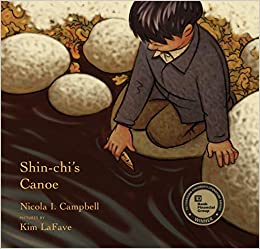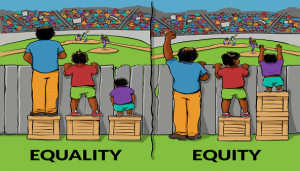Indigenous Perspectives
Shin Chi’s Canoe – Part 1 of 2

Author: Nicola Campbell
Illustrator: Kim Lafave
Links:
Amazon: https://amz.run/4pNH
Indigo: https://bit.ly/3j0U6hW
Social Justice focus: Equity, FNMI
Synopsis: When they arrive at school, Shi-shi-etko reminds Shinchi, her six-year-old brother, that they can only use their English names and that they can’t speak to each other. For Shinchi, life becomes an endless cycle of church mass, school, and work, punctuated by skimpy meals. He finds solace at the river, clutching a tiny cedar canoe, a gift from his father, and dreaming of the day when the salmon return to the river — a sign that it’s almost time to return home. This poignant story about a devastating chapter in First Nations history is told at a child’s level of understanding.
Rationale: I am teaching this lesson as an introduction to the Residential School System in Canada, to give students a jumping off point for concepts such as Reconciliation, Inclusion and Assimilation. Students will be introduced to the concepts of Equity vs Equality in relation to fairness.
Lesson Plan: Ceilidh Stidwill
Primary/Junior/Intermediate Lesson Plan (Abbreviated Template)
Consecutive and Concurrent Programs
Unit/Topic: Equity, FNMI
Grade: 6/7
Lesson: Shin Chi’s Canoe – Part 1 of 2
Curriculum Areas: Language Arts:
Curriculum Expectations:
Overall:
Grade 6 Writing 1: generate, gather, and organize ideas and information to write for an intended purpose and audience
Grade 7 Writing 1: listen in order to understand and respond appropriately in a variety of situations for a variety of purposes;
Grades 6 & 7 Oral Communication 1: listen in order to understand and respond appropriately in a variety of situations for a variety of purposes
Specific:
Grade 6 Writing 1.2: generate ideas about a potential topic and identify those most appropriate for the purpose
Grade 7 Writing 1.2: generate ideas about more challenging topics and identify those most appropriate for the purpose
Grade 6 Oral 1.5: interpret oral texts by using stated and implied ideas from the texts
Grade 7 Oral 1.5: develop and explain interpretations of oral texts using stated and implied ideas from the texts to support their interpretation
Achievement Chart Categories:
- Knowledge: Building knowledge about the complexities of fairness.
- Thinking: Processing information and prompts.
- Communication: Putting the concept of assimilation in student friendly writing. Prompts for oral communication. Prompts for reading.
- Application: Creating an image as a class to represent assimilation. Students will hold up images and use analysis of the collective assimilated flower drawings to grasp the foundations of the concept of assimilation and what that means to identity.
Learning Skills and Work Habits
- Independent work: students will work independently to create a flower that represents assimilation
- Self-regulation: I will encourage that students work in a constructive way and review the class rules
- Collaboration: we will work as a group to find student friendly definitions to words like assimilation and equity
Learning Goal(s):
- I will be able to explain the terms assimilation and equity in a simple way.
- I will create a paragraph related to the terms learned in today’s lesson.
- I will learn about drafting ideas by creating a first draft in my literacy book.
Success Criteria:
- I can explain the terms assimilation and equity in a simple way.
- I can relate the terms learned in class to a situation that happened to me.
- I can write a paragraph and focus on getting the information on paper to create a first draft.
ASSESSMENT TASK /STRATEGY
- Diagnostic: In the minds on I will ask for a show of hands, who knows what equity could mean? Who has heard of assimilation before?
- Formative: Drafting work and revising (later) on being treated unfairly.
- Summative: Exit Card.
ASSESSMENT TOOL(S)
- Exit Card
- Checkmark for working on their writing draft.
PRIOR LEARNING
- Some students will have background knowledge of Orange Shirt Day but for most, this will be an introductory lesson.
DIFFERENTIATED INSTRUCTION
Learning Materials (Content)
- Audio Recordings of questions and instructions
- Ways of Learning (Process)
- Extra time
- Visual Aids
- One on One Time
Ways of Demonstrating Learning (Product)
- Simplified tasks
- Chunking tasks
- Bartering for iPad breaks.
Accommodations:
Student 2:
- 10 min writing, 10 min free time on iPad.
- 10 min writing, 10 min magnetic sand.
Student 1:
- Voice amplifying necklace
Modifications:
Student 1: 3 sentences about being treated unfairly and an image from a google search. Use of iPad for all writing activities.
Student 2: Use of iPad for all writing activities. 3 sentences about being treated unfairly.
Student 3: Record on iPad via voice to text (3 simple sentences).
Student 4: 3 sentences about being treated unfairly and an image from a google search.
MATERIALS / PREPARATION / SAFETY CONSIDERATION(S) FOR TEACHING
8 by 10 white paper____
Pencil Crayons____
Literacy Workbooks____
iPads____
Voice Amplifying Necklace____
Projector____
Images of Equity____
MINDS ON (10 min)
Read the Learning goals of this lesson aloud to students.
- Give each student a sheet of paper box of pencil crayons, pencil and eraser.
- Direct each student to draw a flower any way they like.
- at (1 min) instruct the class that you have changed your mind and the flower must have 5 petals.
- At (2 min) instruct the class that your flower can only have two leaves.
- At (3 min) instruct the class that the flower needs a yellow center.
- At (4 min) Tell the class to finish up.
- Have each student raise their paper and show the class the same drawing.
Prompts:
- How does it make you feel that I kept forcing you to remake your drawing so that it matched what I wanted? Frustrated, sad, annoyed
- Who has heard the term Assimilation before?
- Definition: Define assimilation in kid friendly terms:Assimilation is when you must hide parts of your identity or culture in order to fit in.
- Can you relate this drawing exercise to how assimilation might feel? Yes, because I could not draw the flower that I wanted to make.
ACTION
Show the students the following Equity without the words and then with the words. Proceed with prompts 1.

Prompt 1: What does this image mean to you? Show image without words.
Different people get different things based on needs.
Show second image and proceed with prompts 2 and brainstorming

Prompts 2: Do you know the difference between equity and equality?
What do you think these words mean?
Equality means everyone gets the same treatment
Equity Means everyone gets their needs met so they are at an even playing field.
“That’s not fair”
Has anyone ever said to you “life is not fair”? Why might fairness not always mean everyone gets the same things? Answers: because some people may have less to start with.
Prompt 3: What would be an equitable way to help the person with the broken pencil?
Sharpen the pencil, Give them a second pencil etc.
Sometimes for things to be truly fair, we have to give people who have less advantages more.
Pencil situation: Have students hold up their pencil. Everyone has a pencil but what if mine keeps breaking? (break pencil tip). If life was fair, I would have to do my work with my broken pencil and not get any work done.
See Prompt 3
Have students write a paragraph about a time they were treated unfairly, or you saw someone being treated unfairly.
CONSOLIDATION AND CONNECTION
Exit Card:
One new thing you learned today,
Questions I still have are…
REFLECTION:
- Were my students successful in meeting the learning goals and success criteria? How do I know?
- Did my instructional decisions meet the needs of all students? If not, what are my next steps?
I would like to be able to spend more one on one time with my IEP students. If I were to use this lesson again, I would record simple examples of situations where children were treated unfairly to help generate ideas for their class writing. - What worked well? Why?
- What will I do differently?
- When teaching this lesson again?
- For the subsequent lesson?
- What are the next steps for my professional learning?

